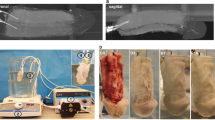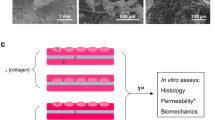Abstract
Penile conditions, such as Peyronie's disease or tumor resection may require surgical reconstruction of the tunica albuginea. Various materials have been proposed, as a biomaterial for tunica albuginea repair, however, little functional data are available. We examined the applicability and functional outcome of a collagen-based matrix derived from the bladder (acellular bladder matrix (ABM)), as a biomaterial for tunica repair. Biocompatibility testing was performed on the matrix, which included mitochondrial metabolic activity, cell viability and apoptosis. Approximately 50% of the dorsal penile tunica albuginea was replaced with the collagen-based matrix patch after surgical removal in 24 New Zealand White rabbits. Cavernosometry and cavernosography were performed. The animals were killed 1, 2 and 3 months after surgery for analyses. The matrix showed excellent biocompatibility. All animals implanted with the matrix survived without any noticeable untoward effects. There was no evidence of inflammation or infection at the time of retrieval. Cavernosometry of the implanted animals demonstrated normal intracavernosal pressures with visual erections. Cavernosography of the repaired corpora showed a normal anatomical configuration. Biomechanical analysis of the retrieved matrices demonstrated similar tensile strengths as native tunica. Histologically, there was only a minimal inflammatory response, which gradually decreased over time. These results show that ABM is biocompatible, durable and effective when used as a tunica substitute. The matrix may be useful as an off-the-shelf biomaterial for patients requiring tunica albuginea repair.
This is a preview of subscription content, access via your institution
Access options
Subscribe to this journal
Receive 8 print issues and online access
$259.00 per year
only $32.38 per issue
Buy this article
- Purchase on Springer Link
- Instant access to full article PDF
Prices may be subject to local taxes which are calculated during checkout





Similar content being viewed by others
References
Dean RC, Lue TF . Peyronie's disease: advancements in recent surgical techniques. Curr Opin Urol 2004; 14: 339–343.
Carson CC, Chun JL . Peyronie's disease: surgical management: autologous materials. Int J Impot Res 2002; 14: 329–335.
Egydio PH, Lucon AM, Arap S . Treatment of Peyronie's disease by incomplete circumferential incision of the tunica albuginea and plaque with bovine pericardium graft. Urology 2002; 59: 570–574.
Leungwattanakij S, Bivalacqua TJ, Yang DY, Hyun JS, Hellstrom WJ . Comparison of cadaveric pericardial, dermal, vein, and synthetic grafts for tunica albuginea substitution using a rat model. BJU Int 2003; 92: 119–124.
Kargi E, Yesilli C, Hosnuter M, Akduman B, Babuccu O, Mungan A . Relaxation incision and fascia lata grafting in the surgical correction of penile curvature in Peyronie's disease. Plast Reconstr Surg 2004; 113: 254–259.
Atala A . Tissue engineering, stem cells and cloning: current concepts and changing trends. Expert Opin Biol Ther 2005; 5: 879–892.
Yoo JJ, Meng J, Oberpenning F, Atala A . Bladder augmentation using allogenic bladder submucosa seeded with cells. Urology 1998; 51: 221–225.
Chen F, Yoo JJ, Atala A . Acellular collagen matrix as a possible ‘off the shelf’ biomaterial for urethral repair. Urology 1999; 54: 407–410.
De Filippo RE, Yoo JJ, Atala A . Urethral replacement using cell seeded tubularized collagen matrices. J Urol 2002; 168: 1789–1792.
Kwon TG, Yoo JJ, Atala A . Autologous penile corpora cavernosa replacement using tissue engineering techniques. J Urol 2002; 168: 1754–1758.
Pariente JL, Kim BS, Atala A . In vitro biocompatibility assessment of naturally derived and synthetic biomaterials using normal human urothelial cells. J Biomed Mater Res 2001; 55: 33–39.
Yoo JJ, Atala A . Tissue engineering of genitourinary organs. Ernst Schering Res Found Workshop 2005; 35: 105–127.
Ciapetti G, Cenni E, Pratelli L, Pizzoferrato A . In vitro evaluation of cell/biomaterial interaction by MTT assay. Biomaterials 1993; 14: 359–364.
Pizzoferrato A, Ciapetti G, Stea S, Cenni E, Arciola CR, Granchi D et al. Cell culture methods for testing biocompatibility. Clin Mater 1994; 15: 173–190.
Abraham GA, Murray J, Billiar K, Sullivan SJ . Evaluation of the porcine intestinal collagen layer as a biomaterial. J Biomed Mater Res 2000; 51: 442–452.
Knapp PM, Lingeman JE, Siegel YI, Badylak SF, Demeter RJ . Biocompatibility of small-intestinal submucosa in urinary tract as augmentation cystoplasty graft and injectable suspension. J Endourol 1994; 8: 125–130.
Wilcox HE, Korossis SA, Booth C, Watterson KG, Kearney JN, Fisher J et al. Biocompatibility and recellularization potential of an acellular porcine heart valve matrix. J Heart Valve Dis 2005; 14: 228–236.
Acknowledgements
We thank Evelyn Flynn, Arthur Nedder, DVM and Laurie Leeds for their technical assistance. We also thank Karl-Erik Andersson, MD, PhD for his editorial assistance. This research was supported, in part, by Acell Inc., the Swiss National Research Foundation and Swiss Urological Association.
Author information
Authors and Affiliations
Corresponding author
Rights and permissions
About this article
Cite this article
Eberli, D., Susaeta, R., Yoo, J. et al. Tunica repair with acellular bladder matrix maintains corporal tissue function. Int J Impot Res 19, 602–609 (2007). https://doi.org/10.1038/sj.ijir.3901587
Received:
Revised:
Accepted:
Published:
Issue Date:
DOI: https://doi.org/10.1038/sj.ijir.3901587
Keywords
This article is cited by
-
Engineering of erectile tissue: the state and future of corporal restoration
World Journal of Urology (2020)
-
Biocompatibility of different nanostructured TiO2 scaffolds and their potential for urologic applications
Protoplasma (2016)
-
One and four layer acellular bladder matrix for fascial tissue reconstruction
Journal of Materials Science: Materials in Medicine (2011)



